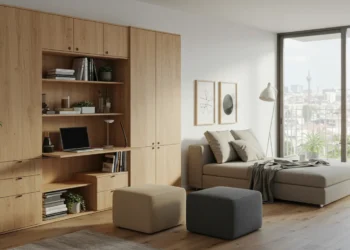You don’t want too much moisture in your living space, especially when that living space happens to be a container home. Too much moisture can cause rust patches to develop on the shipping container walls. These rust patches are more vulnerable to damage and can spring leaks, allowing more moisture to get inside.
Too much moisture can also ruin everything sitting inside your container home. It can cause mold to spread over walls and mildew to cover carpeting. It can make wallpaper peel and paint bubble. It can make wood framing rot. Basically, it can make your interior space completely unpleasant to look at and live in.
So, how do you keep the moisture out of your container home? These are some tips you can follow from the very beginning of the construction process.
Increase the Ventilation
Proper ventilation will stop moisture from getting trapped inside the container home via water vapor, whether that water vapor is from cooking food in the kitchen, running a load of laundry in the dryer or taking a hot shower in the bathroom. Without ventilation, that water vapor will have nowhere to escape. It will be trapped inside, soaking into the surrounding surfaces.
Shipping containers are not built with a lot of vents. They have small vents high up on the walls, but they do not create a lot of passive air circulation. These small vents primarily help with changes in air pressure throughout the freight shipping process.
So, you will have to install more vents! Click here to learn how to ventilate a shipping container properly before you turn it into a functional living space. This ventilation guide will give you a brief list of options for passive and active vents that you can install during your container home construction.
Add Insulation
Moisture can enter your container home, even if you abstain from running appliances or taking hot showers. How? Condensation.
Condensation can form when warm air hits colder container walls. While a little bit of condensation won’t cause any trouble, a lot of it will increase the moisture levels inside the container and cause damage over time.
One of the easiest ways to prevent condensation from forming inside a container home is to insulate it properly during the construction process. Insulation will create a protective barrier between the container’s original steel wall and the interior drywall/wood paneling.
What type of insulation can you choose?
- Fiberglass batt
- Rigid foam board
- Spray foam
- Rockwool
In addition to insulating your walls, you should insulate your exposed plumbing (for example, the drains beneath your sinks). You don’t need a professional to do this. You can go to a hardware store to buy pipe insulation and apply it yourself in a short amount of time. This will stop your pipes from “sweating” and contributing to the moisture levels indoors.

Consider Outdoor Drainage
Rain and melted snow can get through vulnerabilities in the exterior, potentially ruining the interior of your container home. So, you’ll want to install features that will help with drainage. What features can do that?
Also Read Leak Detection 101: Tips to Spot and Stop Hidden Water Wastage
A Graded Yard
The slope of your yard can prevent water intrusion. When the yard slopes away from your container home, water will flow downward and away from the foundation. Gravity will help direct the water to a safer location.
What if your yard doesn’t slope away from your home? Or worse, what if it slopes toward your home? Then, your yard could be sending water around your foundation. This increases your chances of water damage and flooding.
The good news is that you can grade your yard to correct the slope and stop water from flowing straight to your foundation.
A Sloped Roof
A sloped roof is a simple way to prevent water and snow from pooling on top of the container. The slope will force the water to slide off it.
What if you’d like a flat roof? If you prefer a “flat roof” style, you should install a flat roof drain to siphon off any standing water on the roof.
Rain Gutters
Rain gutters collect rainwater and melted snow sliding down the roof. The collected water is directed through a downspout, which expels the water several feet away from the house. Without these features, rainwater and melted snow would slide along the walls of the container home and pool around the foundation.
So, you should install a gutter and downspout system along your roof to increase drainage.
Repair Rust Patches
Rust patches don’t just ruin the curb appeal of your container home. They make your container more vulnerable to damage and water intrusion.
So, when you spot a rust patch, don’t ignore it. Clean off the rust. If there happens to be a hole or a scratch underneath, seal it. Then cover it in a layer of water-resistant paint. This should resolve the problem.
Don’t let moisture wreak havoc on your container home. Follow these tips during the construction process and your home will stay nice and dry!









